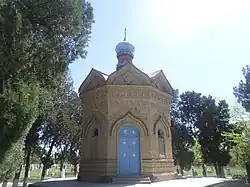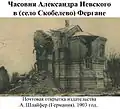| Chapel of Saint Alexander Nevsky | |
|---|---|
 | |
| General information | |
| Address | Fergana, Uzbekistan |
| Construction started | 1892 |
| Closed | 1932 |
| Demolished | 1910 |
| Technical details | |
| Material | baked brick |
| Design and construction | |
| Architect(s) | L. Burmeister |
The Chapel of St. Alexander Nevsky is an inactive Orthodox chapel located in the city of Fergana.[1] It was located at the edge of the Russian cemetery with a sky-blue dome and an entrance gate with the same color. It was built in memory of the Russian soldiers who died in the Andijan uprising of 1898.
Mausoleum was founded in 1891,[2] chapel was built in 1892 with the project of L. Burmeister.[2] The chapel was consecrated on December 6, 1892[2] in honor of Alexander Nevsky. Designed for 50 parishioners.[2] It was closed in 1932.[3] The building was not demolished. One priest was assigned to the chapel. The patronal holiday was set for December 6.[2]
History
In 1898, the Andijan Uprising took place in Uzbekistan, and Russian soldiers were killed in Fergana. They were all buried in the local Russian Orthodox cemetery, after which it was decided to build a chapel at the expense of the local treasury.
The chapel was built of baked bricks and also at the expense of the treasury. Inside, there were also signs with the names of all the dead lower ranks of the Russian fighter, which unfortunately did not survive. Its name was dedicated to the Great Martyr Prince Alexander Nevsky.
In 1910, an earthquake occurred, as a result of which the chapel partially collapsed from the roof. A year later, it was restored. In 1932, the chapel was closed. The building has been preserved by this day. But only memories remained from the cemetery.[4]
Gallery
 Orthodox cemetery
Orthodox cemetery Chapel of Alexander Nevskogo
Chapel of Alexander Nevskogo Inside of roof of chapel
Inside of roof of chapel Mausoleum built in honor of dead Russian soldiers
Mausoleum built in honor of dead Russian soldiers
References
- ↑ "Chapel of Saint Alexander Nevsky (Fergana)". Retrieved 2023-06-11.
- 1 2 3 4 Ivanov Al. A. (2014). History of churches in Uzbekistan. Tashkent.
{{cite book}}: CS1 maint: location missing publisher (link) - ↑ Ruzaev B. A. (1911). History of Fergana Military Department. Kukan.
{{cite book}}: CS1 maint: location missing publisher (link) - ↑ "Chapel of Saint Alexander Nevsky". Retrieved 2023-06-11.